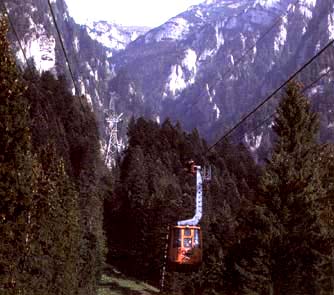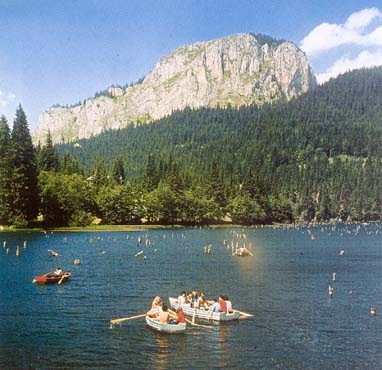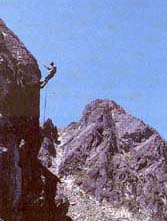Prahova Valley, at the foothills of the Bucegi mountains is Romania's most popular ski area with four major resorts: Sinaia, Busteni, Predeal and Poiana Brasov. It's also a favorite place to hike.
Sinaia and its northern neighbor Busteni are nestled in the valley of the western Bucegi mountains about an hour north of Bucharest. Sinaia is also the home of the magnificent Peles Castle. Farther north, Predeal straddles both sides of the train route between Bucharest and Brasov. This is the most popular winter sports resort; it has snow more than 100 days a year.
Poiana Brasov, at 3,400 feet altitude, is only 9 miles from Brasov by bus. It is the best equipped resort, with 12 ski tracks. There are also football, basketball and handball fields, swimming pools, a fitness club and sauna.
The most famous resorts in the higher, eastern Carpathians are: Durau, Vatra Dornei and Borsa.
Vatra Dornei looks up to the high peaks of Rarau-Giumalau mountains. It is well known for its mineral waters, as well as for its ski tracks. Borsa is in the north, at the bottom of the Rodnei mountains in Maramures. Along with the winter snow sports, enjoy endless exploration of the 6,600 foot high mountains.
Durau is situated at the base of the Ceahlau mountain, one of the favorites of mountaineers.
Hiking and Camping
The Retezat Mountains, on the western side of the southern Carpathians, are the rockiest massif of Romania. Declared a National Park in 1935, they cover 32,000 acres and have 100 glacial lakes and over 300 flower species. The Paltinis resort, near Sibiu, looks like a medieval fortress and is the best place to spend a mountain holiday during summer or winter.
In the eastern Carpathians, at Campulung Molodovenesc, at the foot of the Rarau mountains, is Pietrele Doamnei, calcareous rocks over 230 feet high with Secondary age sea fossils; and Slatioara, with 400 year old trees 160 feet tall.
The Bicaz Gorge, three miles long, with 980 feet high walls and more than 300 flower species, has challenging mountaineering routes and caves.
Piatra-Neamt has one of the most important deposits of marine fossil fauna; also "the Bear's Basins", wind erosion in gritstone.
Caves
The Ursilor Cave (Cave of the Bears), is at 1,600 feet in the Padesul tableland in the Apuseni mountains, near the town of Stie. It is 3,300 feet long, on two levels, containing skeletal remains of bears and ancient human hearths.
The Muierii Cave (Cave of the Women), is on the southwestern slope of the Capatanii mountains in the southern Carpathians.
Izvorul Tausoarelor is the deepest cave in Romania decending 1,500 feet on the southern slope of the Rodna mountains of the northern Carpathians, near the town of Nasaud. It has exceptional halls, falls, whirlpools and cavern fauna.
Topolnita Cave is one of the largest caves in the world, at 33,000 feet long. It is located in the Mehedinti tableland in the southern Carpathians near Drobeta-Turu Severin. Created by four rivers vanishing into the pit, it has four levels, drifts of 3 - 65 feet high, major halls, shaft pits, siphons and lakes.





